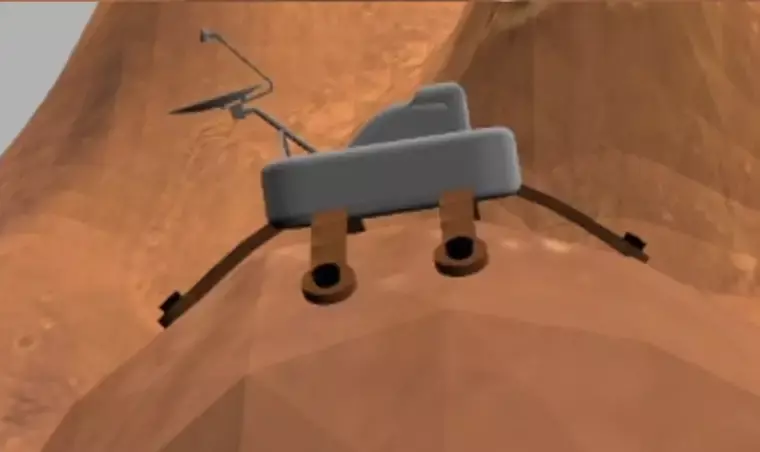A paper presented at the 74th International Astronautical Congress by researchers from the GRVC Robotics Lab at the University of Seville, Spain, proposes a novel concept for exploring alien worlds with soft morphing aerial robots.
The revolutionary approach leverages flexible, adaptive materials, enabling the robots to perform full-body perching and land on uneven terrains.
Researchers suggest that the development of these soft morphing aerial robots could significantly advance space exploration. Their unique design and adaptability promise a more effective and flexible approach for investigating planets and moons with demanding and complex terrains, like Saturn’s moon, Titan.
“By controlling the deformation of the multi-rotor arms, this robotic explorer can achieve full-body perching, allowing it to settle on uneven terrains, thus unlocking new exploration horizons and sampling possibilities,”” wrote researchers. “”The in-depth conceptual design of this aerial robot holds significant potential for Titan exploration, specifically in the region of the Sotra-Patera Cryovolcano.”
Using Saturn’s Titan as a Proving Ground
For proof-of-concept, researchers primarily focused on Saturn’s moon Titan. The natural satellite offers an intriguing landscape with lakes, dunes, and cryovolcanoes.
Titan also resembles Earth, with a dense atmosphere and complex methane cycle, making it a prime target for exploration. However, its challenging terrain has always been a barrier. An obstacle that these soft morphing aerial robots hope to overcome.
The drone’s multirotor arms, actuated by a pneumatic system and a tendon mechanism, are at the heart of this technology. This design allows the arms to deform and adapt to different surfaces, making landing and sampling on rocky, irregular, or uneven terrains possible.
Additionally, the arms can morph partially in flight to navigate through tight spaces, a crucial feature for exploring the complex topography of celestial bodies like those found on Titan.
A standout feature of this novel soft morphing aerial robot concept is the ability for the drones to perform full-body perching. This means they can land and take off from surfaces inaccessible to conventional landers and rovers, such as rocky outcrops or uneven grounds.
The challenge of enabling a space drone to execute full-body perching will likely be one of the most significant hurdles in bringing this innovative design to reality.
Last year, in a breakthrough within the European Union-funded GRIFFIN project, researchers successfully showcased an ornithopter drone autonomously flying, landing, and perching on a tree branch using a claw system resembling bird talons. This marked the first instance of a large, autonomous ornithopter achieving such a complex maneuver, previously unattainable for drones.
“It is a difficult maneuver to achieve as the system required to hold the robot’srobot’s weight on the branch needs to be integrated within a forward flying vehicle that needs to land at a precise location autonomously,” Dr. Raphael Zufferey, a postdoctoral fellow at the University of Seville and lead author of the GRIFFIN study, told The Debrief.
By integrating adaptable and flexible materials into the overall design, Seville researchers believe their soft morphing aerial robot explorer could perform these complex perching maneuvers, even in the extreme conditions of outer space.
Researchers used the open-source 3D robotics simulator, Gazebo, to validate their proof of concept.
“To closely replicate Titan’sTitan’s diverse landscape, the Gazebo world was equipped with a variety of terrains, including rocky outcrops, icy patches, and others,” researchers wrote. “These features ensured that the robot was tested under conditions mimicking the complexities it would face on the actual moon.”
The aerial robot’s design successfully demonstrated fully-actuated sideways movement in detailed simulations. It could also alter its shape during flight to adapt to various flight modes or interact more effectively with its environment.
The soft morphing aerial robot was also able to successfully land and perch on various terrain models, with the tendons in the drone’s arms maintaining tension and ensuring a secure grip on landing surfaces.


Another critical challenge addressed by the study was the behavior of deformable materials under extreme conditions found on alien worlds.
Conducting experiments using liquid nitrogen to test various materials at cryogenic temperatures, researchers found that Teflon (PTFE) presented a particularly promising option due to its thermal stability and flexibility at low infill rates.
Beyond Titan: The Broader Impact of Morphing Aerial Robots
This recent study focuses primarily on Titan, but the possibilities for using these soft morphing aerial robots in space exploration reach much further.
The key to effective space exploration is efficiency – in energy use, data collection, and terrain navigation. With reduced aerodynamic drag and enhanced flight efficiency, this novel design could address all of these needs.
Additionally, the ability of soft morphing drones to cover long distances efficiently and adapt to different environmental conditions could make them ideal for exploring all types of challenging terrains, including those here on Earth.
The next logical step will involve proving that a scaled prototype of the soft morphing aerial robot can replicate the successful outcomes of 3D simulations.
The in-depth conceptual design of this aerial robot holds significant potential for Titan exploration, specifically in the region of the Sotra-Patera cryovolcano,” researchers wrote. “In conclusion, this concept enhances overall safety and exploration potential, making it promising for future exploration of Titan.”
Tim McMillan is a retired law enforcement executive, investigative reporter and co-founder of The Debrief. His writing typically focuses on defense, national security, the Intelligence Community and topics related to psychology. You can follow Tim on Twitter: @LtTimMcMillan. Tim can be reached by email: tim@thedebrief.org or through encrypted email: LtTimMcMillan@protonmail.com

